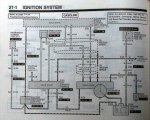yo Cassandra,
WELCOME!
As Seabronc & Bob advised;
and this is by Ford;
"•Severe Belt Flutter
Loose drive belt.
CHECK belt tension and ADJUST (manually tensioned belts only) if necessary. CHECK condition of drive belt and REPLACE if necessary.
•Binding tensioner arm.
REMOVE drive belt from drive belt tensioner and VERIFY that tensioner arm is not frozen in position or that arm does not bind when manually moved throughout its operating range.
•Drive Belt Jumps off Pulley
Greatly misaligned pulleys.
CHECK for misalignment between adjacent pulleys.
•Pulley wobble.
VERIFY that no pulley wobbles during engine operation. Conditions causing wobble are: bent pulley, bent accessory shaft, rear face of pulley not seated flat against mating surface.
•Excessive crankshaft end play.
REBUILD engine.
-
Power Steering Pulley Alignment
SPECIAL SERVICE TOOL(S) REQUIRED
Description
Tool Number
Steering Pump Pulley Remover T69L-10300-B
Steering Pump Pulley Replacer T65P-3A733-C
A chirping noise from the accessory drive belt that is more noticeable at idle than at higher speeds may be caused by a power steering pump pulley (3A733) that is out of alignment.
The misaligned power steering pulley causes the accessory drive belt to chirp as the belt enters it on an angle on 4.9L engines, or after it leaves the power steering pump pulley, travels over the water pump pulley (8509) and enters into the crankshaft pulley (6312) on an angle on 5.0L and 5.8L engines. Verify that the chirping noise is coming from the entrance to one of these two pulleys by listening through a length of rubber hose or another stethoscope-like device.
If the chirp has been isolated to one of these pulleys, then correct this condition by aligning the power steering pump pulley using the following service procedure.
NOTE: Accessory drive belt chirp not corrected by this procedure may be caused by a damaged pulley or bent accessory shafts. Steady pulsation of the drive belt tensioner (6B209) indicates this condition. Observe each pulley in the system for runout.
1. CAUTION: Do not sand the edges of the drive belt or apply lubricants or dressings. These are only temporary fixes and may damage belt.
Clean the accessory drive belt (8620) with mild soap and water to wash away oil or other contaminants.
2.On some models, it may be necessary to remove the fan shroud (8146) to allow for proper installation and operation of the power steering pulley puller and installer tools.
3.Using Steering Pump Pulley Remover T69L-10300-B and Steering Pump Pulley Replacer T65P-3A733-C set the power steering pump pulley hub to within ±.010 inch of being flush with the end of the power steering pump shaft.
4. CAUTION: Damaged accessory drive belts should be replaced before proceeding to Step 4. Only use a closed-end wrench to lift the drive belt tensioner to avoid possible damage. A wedged screwdriver will crack the pulley or the housing.
Operate the engine (6007) at idle for five (5) minutes to see if chirping noise has been corrected. If not, proceed to Step 5.
5.Select a direction and move the power steering pump pulley at .50mm (.020 inch) increments in that direction. After each move (increment), remove the tool and operate the engine for five (5) minutes. If chirp fades, alignment is being achieved; if chirp increases, reverse the alignment direction. Continue moving the pulley until the noise is eliminated.
6.Reinstall the fan shroud.
-
The drive belt tensioner (6B209) has no provision for adjustment and will be damaged if forced to travel beyond its operating range.
---
With the engine running, check drive belt tracking (the position of the drive belt on the drive belt tensioner). If the edge of the drive belt rides beyond the edge of the drive belt tensioner, this can cause noise and premature wear. If a drive belt tracking condition exists, visually check the drive belt tensioner for damage, especially the mounting pad surface. If the drive belt tensioner is not installed correctly with the locating pins in the locating holes, the mounting surface pad will be out of position. This will result in drive belt tension and chirp and squeal noises.
If the above procedures do not correct the drive belt noise, try replacing the drive belt with a known good original equipment drive belt. However, the drive belt noise may return again (with mileage) if one of the above conditions still exists uncorrected.
•With engine running, visually observe the grooves in the pulleys (not the pulley flanges) for excessive wobble. Replace components as required.
•Check all accessories, mounting brackets and drive belt tensioner for any interference that would prevent the component from mounting properly. Correct any interference condition and recheck belt tracking.
•Tighten all accessories mounting brackets and drive belt tensioner retaining hardware to specification. Recheck drive belt tracking.

